
 Interview
Interview


![]() Part 1: Tips on enjoying a Noh performance
Part 1: Tips on enjoying a Noh performance
![]() Part 2: A history as a performer marked by a respect for the basic techniques
Part 2: A history as a performer marked by a respect for the basic techniques
Interviewer: Takahiro Uchida, the-Noh.com / Photos: Shigeyoshi Ohi
Part 2: A history as a performer marked by a respect for the basic techniques
From first appearance to rōjomono
Uchida: I wonder if you would now be so kind as to give us a brief overview of your career to date, including your time as an apprentice.
Kongō: My first appearance was a shimai performance in Shōjō when I was four years old. I was born in June 1951, but my grandfather (Iwao Kongō I) had already passed away so it was my father (Iwao Kongō II) who taught me my craft.
I made my first stage appearance at Ise Jingū – The Grand Shrine of Ise. It was here, too, that I made my debut as a shite (lead actor). That was also in the Noh Play Shōjō, and I was about six years old. At that time, the Kongō family was making its kagura (ceremonial music and dance) offering to the gods enshrined at Ise Jingū. There was no permanent stage then and I danced on a stage that had been erected for the occasion.
Uchida: So you were offering (the gods) a gift of celebratory Noh dance, then?
Kongō: That’s right. As a child I also performed in Kokaji (The Swordsmith) and Makura-jido (aka Kiku-jido in other schools), and most of my appearances were as kokata – roles played by children. In the Kongō school, actors always perform the ceremonial hatsuomote (literally, “first mask”, or the dance marking their entrance into the world of professional Noh actors) in Okina ; it’s a house rule, so to speak. I was sixteen when I donned my first mask.
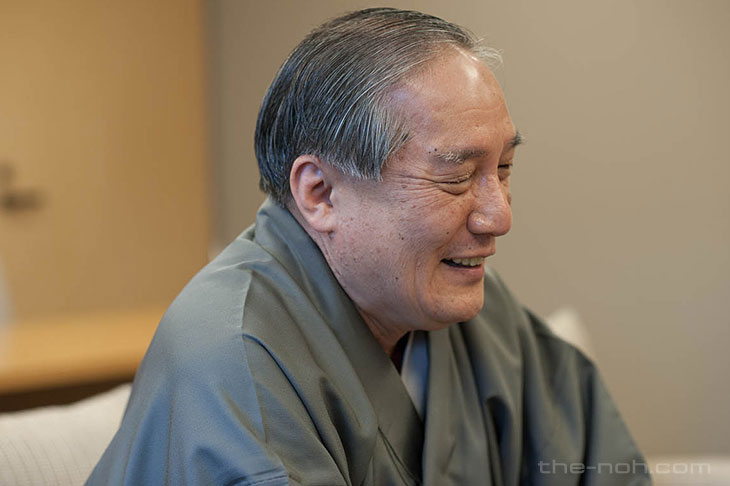
Uchida: Is there a reason why the Kongō School perform hatsuomote in Okina?
Kongō: I think it’s because the play bears such ceremonial significance. The wearing of a mask is a ceremony in and of itself, which is why, perhaps, the Kongō school chooses Okina to mark the important milestone that is hatsuomote.
I was twenty when I performed Dōjō-ji (Dōjō-ji Temple). That performance remains deeply etched in my mind. I was more than a little nervous.
Uchida: It’s a tremendously significant hiraki-mono for Noh actors, isn’t it?
Kongō: It was the first time the kotsuzumi (shoulder-drum) drum player Masahiro Sowa (Kō school) had performed Dōjō-ji, too.
Uchida: What makes Dōjō-ji so difficult to perform?
Kongō: The shite’s entrance song is technically demanding, it features a ranbyōshi (literally, “confused rhythm”) with the kotsuzumi drum player, there’s the contemplation of the bell with the ōtsuzumi (hip-drum), and then the scene where the shite enters the bell... The play is visually enthralling for the audience, but the difficulty of the performance for the shite is virtually impossible to articulate.
The yumiya-no-tachiai* that I performed with the grand masters of other schools beginning in my late twenties are another high point in my career, I think. Besides the events staged in Kyoto that I hosted with other shite as my guests, there were big events in Kobe and Tokyo; it’s an exceptional performance and I seized every opportunity to dance it.
Uchida: Special performances such as this are truly too good to be missed, aren’t they? Can you recall any other appearances that were particularly memorable?
Kongō: This takes us back in time a little, but my performance of a hiraki in Sagi (Heron), which can only be performed by elderly actors or young boys, is another outstanding moment. I was twelve or thirteen at the time, but I remember standing on stage in Nagoya and Kyoto with Mitsunaga Maekawa, the taikokata (percussionist) from the Komparu School, who is a year younger than me, and Rokurō-Byōe Fujita from the Fujita School of Noh flutists (or fuekata), who is two years my junior. Prior to this performance of Sagi, I also performed Shōjō Midare and the red lion dance in Shakkyo.
As I got older, I performed the serious Ataka and Mochizuki plays, and at forty took on my first rōjomono (one of five plays that feature an old woman as the shite) in Sotoba Komachi. I have since performed Sekidera Komachi and other of the rōjomono plays.
* Yumiya-no-tachiai (literally, “a confrontation of bows and arrows”) refers to a special performance of Okina in which three Okina players stand on stage and dance the same role simultaneously and in competition (with one another). Originally, Okina was performed by three grand masters from different schools. During the Edo Period, the song was performed in the Utaizome-shiki – a New Year’s ceremony for the first Noh performance of the year that was performed in the home of a shogun.
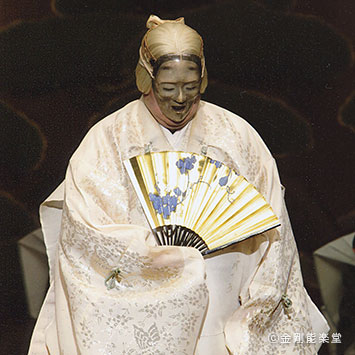
Hisanori Kongō in a December 6, 2014 performance of Obasute (The Old Woman Abandoned in the Hills), one of the weightier Noh plays that actors only become qualified to perform with age.
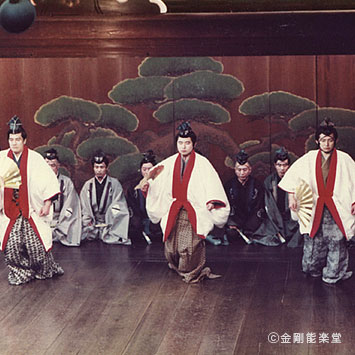
Yumiya-no-tachiai (or confrontation of bows and arrows) in a special performance of Okina.
Performers must stretch themselves to the utmost
Uchida: As a family head, what aspects of your craft do you give particular emphasis to?
Kongō: For me, the most important thing is to give each and every performance my all and to never, ever cut corners. People say that Noh performances are once-in-a-lifetime experiences, and since each play is normally produced only once by the same ensemble that feeling essentially emerges of its own accord.
Uchida: The preparations involved must be incredibly arduous, I think.
Kongō: It’s important to keep in good physical shape, too. In my youth, the late Rokurō Umewaka (the 55th) of the Kanze school danced Morihisa (which comes from the story “Heike Monogatari” or “The Tale of the Heike”) for a five schools of shite performers’ event that was hosted by the Asahi Shimbun. I was backstage, but I witnessed Umekawa collapse upon returning to the dressing room following the end of his performance. It was at this point that I realized that Noh demands its actors give the greatest performance of their careers each and every time they appear on stage.
In Noh, it is possible for actors to stint on their performance, if they so chose, but in my opinion such performances no longer qualify as Noh. For various reasons it’s vital to maintain a sense of tension from beginning to end.
Uchida: Even so, to have exerted so much energy dancing a single play that you collapse at the end of it is quite extraordinary, wouldn’t you say?
Kongō: That’s one of the reasons why it’s impossible to do a run of Noh plays. The amount of energy a shite-kata condenses into the performance of a single play is tremendous, and the pursuit of that is what makes Noh, Noh. The audience will soon know if an actor is attempting to temper his performance.
Uchida: Would it be correct to assume that you have absorbed a great deal from you predecessors?
Kongō: As a young man I was mesmerized by Susumu Takahashi of the Hōshō school. I was also privileged to see Kondō Kenzō (Hōshō school) perform Aya no Tsuzumi (“The Damask”, a Noh play by an unknown author that depicts the evil consequences of unrequited desire) in Kyoto, though I only saw him in action on that one occasion. I’ve had the honor of seeing many master shite-kata on stage, including the late Rokurō Umewaka, the current Gensho Umewaka, Tokuzō Gotō and Minoru Kita of the Kita school, Michio Sakurama of the Komparu school, and many, many more. Among hayashikata (the instrumental performers in Noh), the naturalistic drumming of Toshio Kamei of the Kadono school was particularly memorable, whilst the jo no mai performed by the late Daigoro Fujita who belonged to the Isso school of Noh flutists shook me to the core. The waki-kata (supporting actor) Kan Hōshō, meanwhile, was a supporting actor who returned considerable energy to the shite he performed with.
Uchida: I realize this must be difficult to put into words, but what would you say you’ve gained from your various forerunners?
Kongō: It’s certainly something that’s intuitive, which makes it hard to articulate, but if I were to attempt to put it into words, I’d say it’s the necessity of having a solid core or nucleus. Hisao Kanze had it. Susumu Takahashi, too, had a center that never lost its energy. Actors who lack this level of energy, this core, always seem a little glib in their performances. It’s a matter of resolve, I think, or grit. Noh actors need a solid core or nucleus and the ability to evoke an emotional atmosphere externally.
What else? Noh plays require changes in air, too. When Susumu Takahashi took the stage and performed a rongi sequence, the atmosphere would change completely. Hisao Kanze, too, could transform the emotional universe on stage in plays like Akogi. His ability in this respect was quite extraordinary, though I’d be hard pushed to explain why.
Uchida: Chancing on a performance like that would be truly fortuitous, wouldn’t you say?

The heads of the Noh households serve to preserve the constants in the Noh tradition
Uchida: As the head of a shite-kata school, what do your days entail?
Kongō: Noh has changed considerably over the course of its long, long history, but this is a highly codified performing art and there are many aspects that are immutable. It is these, I think, that the heads of the shite-kata schools are safeguarding. Long-established arts like Noh need to be both unvarying and open to change. Change is necessary in order to move with the times, and it is the great performers who must bring about those changes. At the same time, preserving those parts of the tradition that are immutable falls to the heads of the various Noh schools, and historically they have performed the task of safeguarding those elements that are essential to Noh as a theatrical art. This is precisely why Noh has survived for as long as it has.
Uchida: The Kongō school is the only one of the five Noh schools to be based in Kyoto. What significance does that hold?
Kongō: Opera, which I love, is an art of considerable stylistic diversity. As might be expected, the same opera will look completely different depending on whether it’s staged in Germany, Italy, France, or Russia, and in Germany and Italy, for example, the staging will vary significantly depending on the city in which its performed. It is this diversity that gives opera its richness, and that is important. Likewise, I think Noh benefits from variety. That there are differences between Noh as performed in Edo and Noh as performed in the Kyoto-Osaka region is fascinating.
The Tokyo schools of Noh preserve vestiges of the samurai-style of music that was performed in the Edo period. In Kyoto, however, Noh has traditionally been performed primarily for the Imperial court and so it retains traces of the court culture and a softness of atmosphere as a result.
In the kyōgen world of comic theater, there are palpable differences in the performing styles of the Shigeyama family of Kyoto and the Yamamoto family of Tokyo, though both belong to the Ōkura school. Mind you, such (regional) differences are probably not as marked in the world of Noh.
Uchida: The two streams are what gives Noh its richness and vitality.
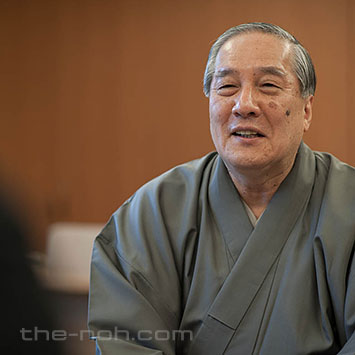
“The basics constitute the essence of the art,” says Hisanori Kongō.
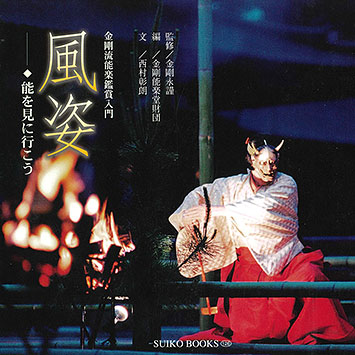
Kongō-ryu nohgaku kanshō nyūmon Fūshi – Noh wo mi ni ikou (“Visual Aspect – Let’s Go See Noh: An Introduction to Appreciating the Kongō Style of Noh”): an informative guide to the attractions of the Kongō style of Noh featuring spectacular photographs and highly readable explanations, with Hisanori Kongō as supervising editor.
Initiation (into the mysteries of Noh) lies in the basic techniques
Uchida: You’ve said that Noh includes elements that are open to change and elements that must be safeguarded. That relates to the carrying on of the Noh tradition, does it not? Would you mind talking a bit about how the art of Noh is handed on to successive generations?
Kongō: Both Kyoto and Osaka have Nohgaku Yōseikai, a training academy system for Noh theater, where students are given a solid grounding in the art of Noh that includes hayashikata (the instrumental performers). I, too, offer learning opportunities for budding shite-kata – the movement sequences of the lead actors – at the training academy, but the system functions superbly thanks to the cooperation of the various members of the Kansai-based schools of Noh.
With practice sessions, it’s important to concentrate on mastering the basic techniques. The basics never change. Doing your best to acquire the basic artistic skills you learn in the very beginning is what will give you your initiation into the mysteries of the art of Noh.
Uchida: Essentially, then, it’s necessary to master the basic movement segments (the kata) and chants (the utai)?
Kongō: Precisely. The sliding feet of a Noh walk – the hakobi – are what constitute the basic movement in Noh dance. The chants change a little from one generation to the next, but the way in which the voice is projected, the vocalization – those aspects are universal. You cannot dance Noh unless you have mastered the basics – how to use your body, for example, and kamae, the basic stance that is kept throughout the dance. Once you’ve mastered those techniques and that knowledge is cemented, then it becomes possible to imbue your art with individuality.
Uchida: The road to mastering the basics is a long one, then?
Kongō: Yes. Getting the hakobi – the sliding feet of a Noh walk – right is a never-ending process. But once you’ve mastered the hakobi, it is possible to dance Noh. And once you’ve learned how to sing the utai then your Noh performance will begin to take shape. I sense that the Noh I dance is essentially comprised of the basics.
The basics of the great performers are truly wondrous to behold.
Uchida: This relates to what you were saying earlier about the need to form a core or nucleus, does it not?
Kongō: Routine practice of the basic techniques is what will – eventually – form the core of your skill as an actor.
Uchida: Ultimately, then, it’s a matter of accumulating the basic techniques.
Kongō: In the Kongō household there’s a hidensho – a secret manuscript on the art of Noh – that’s off limits until the family successor is at least forty, but even that includes just two references on the basics of how to channel energy when using your hands and feet.
That’s just reminded me of something. Following the dance that was performed at a ceremony to mark Kazufusa Hōshō’s succession to the position of current family head, Yasuo Imai offered his guidance on hand grips, which reminded me of the secret manuscripts of the Noh households. By all accounts, Kanesuke Noguchi was spoken to frequently on this subject. On the authority of Yasuo Imai, whilst reviews of performances by Kanesuke Noguchi are full of references to the roundness of his hands, in fact great strength was at work.
Performing the basic techniques correctly is more important than anything else, and the accumulation of that knowledge comes through practice.
Uchida: Talk of initiation and secrets is wont to suggest that the world of Noh is highly secretive, but that’s not actually the case, is it?
Kongō: What matters is attentiveness to the absolute basics. If those are loose then the whole performance will lack unity. The basics constitute the essence of the art.
I see it as my duty to impart the importance of maintaining these basic techniques to young actors learning the art of Noh today. Patient practice of the basic techniques day in, day out is the way to hone one’s skills as an artist. (End of Part 2)
March 2, 2017
Hisanori Kongō(金剛永謹), 26th-generation head of the Kongō School of shite-kata (lead actors)
Born in Kyoto in 1951 as the eldest son of Iwao Kongō, the 25th-generation Grand Master of the Kongō school. He began studying under his father in early childhood, making his stage debut at the age of four and his first appearance as the shite at six years of age. He is a holder of important intangible cultural heritage (collective recognition). On September 18, 1998, he succeeded his father to become the 26th-generation Grand Master of the Kongō school. Hisanori Kongō is acclaimed for bringing the refinement and elegance of Kyoto to the Kongō style of Noh, which is known as “Mai-Kongō” (or “Dancing Kongō”) and is renowned for its uniquely flamboyant and dynamic style. Of the five shite-kata family heads, he is the only one to be based in the Kansai region. 2003 saw the completion of work to relocate the Kongō Noh Theatre from its former location in Shijo Muramachi to the west side of the Kyoto Imperial Palace. Beginning with Canada and North America, Hisanori Kongō has toured overseas a number of times as the head of a troupe of Noh performers, performing in Italy, Spain, France, Portugal and elsewhere.
He is the recipient of the Kyoto Municipal New Artist Award (1984), the Kyoto Prefectural Culture Award’s New Artist Prize (1986) and the Kyoto Prefectural Culture Award’s Person of Cultural Merit (2004). In 2010, he received an Order of Merit for Distinguished Service to Culture from Kyoto City.
He is managing director of the Nihon Nohgaku-kai, President of the Kongōkai, and President of the Kongō Nohgakudo Foundation, as well as a visiting professor at the Kyoto City University of Arts and the Doshisha University. He is the author of a work entitled “Kongō-ke no Men” (“The Mask of the Kongō Family”)
Interviewer: Takahiro Uchida (内田高洋), the-Noh.com
Uchida entered the Noh club of the Hosho School at Kyoto University and became captivated by the art there. Since then, watching plays and learning about all aspects of Noh, he has practiced singing and dancing with the Hosho School as well as playing fue (flute) at the Morita School and taiko (stick drum) at the Kadono School. He also writes and edits the Hosho newsletter of the Hosho School.


